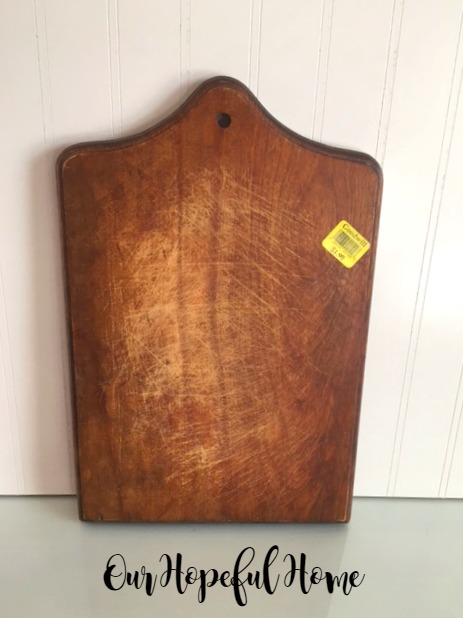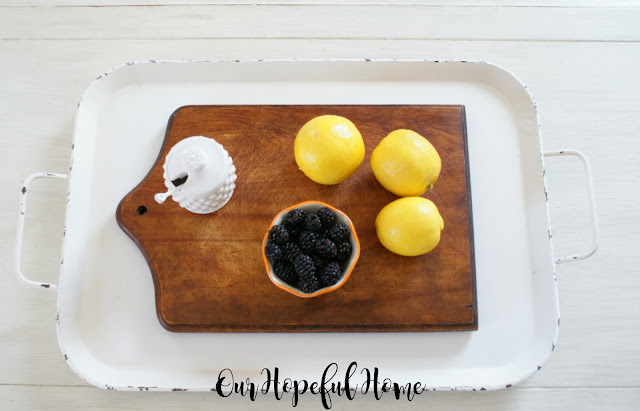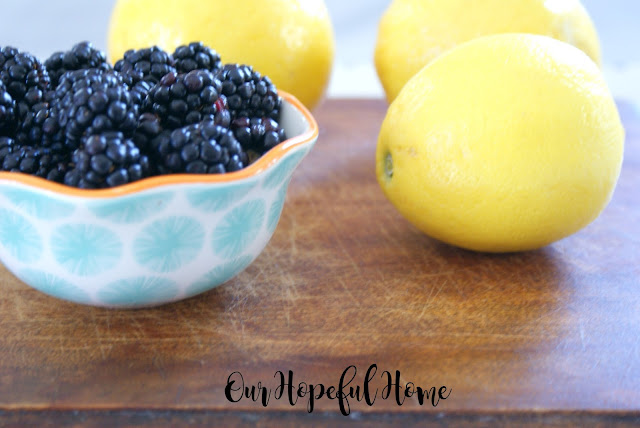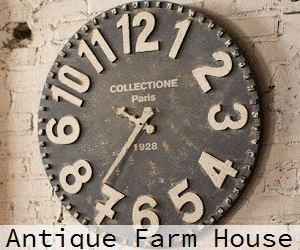I don't know about you, but we use wooden cutting boards a LOT around here. And as much as I enjoy cooking, I really do have to fess up and admit that my husband does, oh, 99% of the cooking around here. (Lucky girl, right?) But no matter who's the cook, we all need clean cutting boards. As a bonus I'd like mine to be nice looking, too. Not like those old, scratched up and worn looking wooden cutting boards. Ugh. And as much as I love the look of vintage cutting boards, if it's going to be used as more than a display piece, it has to be sanitized first. Period.
After thorough research I've come to the conclusion that there is more than one way to sanitize a cutting board, including both wooden and plastic ones. At the end of this post I will list some options for sanitizing and revitalizing your cutting boards with basic, eco-friendly ingredients I'm betting you already have in your pantry. But first, let me share what I did to clean and revitalize my own thrift store cutting board. Then I'll show you how it came out and let you be the judge.
Step number 1: Score yourself a thrift store cutting board. (Or use your own.) Mine was $1.99 from Goodwill.
If it's wood, and assuming it has unsightly scratches (that probably harbor bacteria, ick) you'll need to sand it down to a smooth finish. I chose to use an electric sander, but you can also use a sanding sponge or sanding block depending on the severity of the scratches.
All the online tutorials I read made is sound so simple. Basically they say just sand away the scratches and voila, you have an almost-new looking cutting board. Unfortunately, I did not find that to be the case. More on that later.
The cleaning method I used involved lemons, coarse salt and coconut oil.
After sanding it, I washed the cutting board with dish soap and water, then allowed it to dry. A deep cleaning followed, consisting of pouring coarse salt over the board and then rubbing the salt into the board with lemon juice from the side of a lemon. I let that sit for 10 minutes before rinsing well with hot water. Once it fully dried again I took a paper towel dipped in coconut oil and rubbed it into the board in order to revitalize its finish. (You can also use any food grade mineral oil as well. Do not use other organic oils since the fats in them will eventually go rancid and stink. Enough said.) I have to say that I was disappointed with how my cutting board turned out.
Doesn't look a whole lot different than the original, huh? So what went wrong? All I can figure is that I did not sand it well enough. After all was said and done I decided I would use it for display rather than a day-to-day cutting board.
I don't think it looks too bad as a display board. Just worn-out-enough-looking to have some character. At least that's what I'm telling myself.
8 Ways to Disinfect a Cutting Board
(All methods are approved for both wood and plastic cutting boards.*)1. Use a paste made of 1 tbsp. each baking soda, coarse salt and water. Scrub the board well with the paste and rinse with hot water. Let dry.
2. Wipe your boards with full strength vinegar after each use to clean them.
3. For disinfecting and deodorizing, spread the board with baking soda and spray with white vinegar. Watch it bubble like a sixth grade science project for 5-10 minutes then rinse with cold water. This process is good for removing stains and smells.
4. To disinfect use either pure white vinegar or a mixture of 2 tsp. chlorine bleach (albeit not eco-friendly) in a gallon of water. Wet a cloth with either solution and wipe the board down with it (or scrub).
5. Scrub the board using coarse salt and juice from the side of a lemon. Rinse with hot water and let dry.
6. One article I read actually said to clean the board first with vinegar, then hydrogen peroxide, then apply sea salt overnight and finally rub it in with a lemon then rinse and dry. Whew!
7. After cutting meat, disinfect the board with 3% hydrogen peroxide. Pour the solution over the board, let stand for 5 minutes, scrub with a scrub brush then rinse with hot water and let dry.
8. For stubborn odors like garlic, you can use grated potatoes or apples. (Apparently, they contain enzymes that do a job on odors. Who knew?) Simply cover the board with approximately one tbsp. of either grated potato or grated apple and let sit for 10 minutes. Then rinse off.
*PLEASE NOTE: While I did not experiment with a plastic cutting board, I did read that the best way to clean plastic cutting boards is to soak them 5-10 minutes in a mixture of 1 tsp. chlorine bleach and one gallon of water, then scrub with dish detergent and hot water. Since chlorine bleach is not exactly eco-friendly you can always use straight white vinegar instead. I also read that you can even sand down the cuts and scratches on a plastic board with a coarser grit sandpaper followed by a finer grit sand paper. Then clean well (see list above), of course.
So are you sufficiently confused, like I was? I wouldn't be surprised if you were. Despite all the different cleaning advice, I do have a short list of tips which should be helpful in the general day-to-day care of your cutting boards.
General Tips For Cutting Board Care
1. Never put a wooden cutting board in the dishwasher. (Too much water can warp the board!)2. Never leave a wooden cutting board to soak in a sink full of water. (See number 1.)
3. After cleaning it, always stand your wooden cutting board up to dry so that both sides dry equally.
4. If at all possible, avoid cutting meat and chicken on your wooden cutting boards. Save that for your plastic cutting boards.
5. If you have to cut meat and/or chicken on your wooden cutting board, do not let blood pool on the wood for long periods of time. It will just soak into the cracks and crevices. Ew.
So there you have it. Yes, you can clean your cutting boards (and you should clean the ones you use regularly!) And you might just be able to extend its life with a good sanding (and coconut or mineral oil rubbing if it's a wooden board). I'll probably try the sanding option again at some point with my wooden cutting board but for now I'm happy to sit back and let my husband take care of all the cooking details! Seriously, he really is the best. No matter what our cutting boards looks like!
Well, that's it until next time!
I hope you enjoyed reading 8 Eco-Friendly Ways
to Disinfect a Cutting Board
With Ingredients From Your Pantry.
With Ingredients From Your Pantry.
Thanks for spending time with me today!
Don't forget to Pin it!
Be sure to stay in touch:

Don’t miss another thrifty,
DIY home décor post!
























Leave a Comment!
I love the worn look of the board! It's perfect! Of course, clean and perfect is even better!
Great tips, Kathleen! Also, since you've mentioned photography skills previously, I just have to say what a pretty photo this is ;) I stopped buying "cleaning" products some time ago. Like your post, I prefer natural and find that lemons, vinegar, baking soda and coconut oil cover almost anything. I also love using essential oils.
Post a Comment